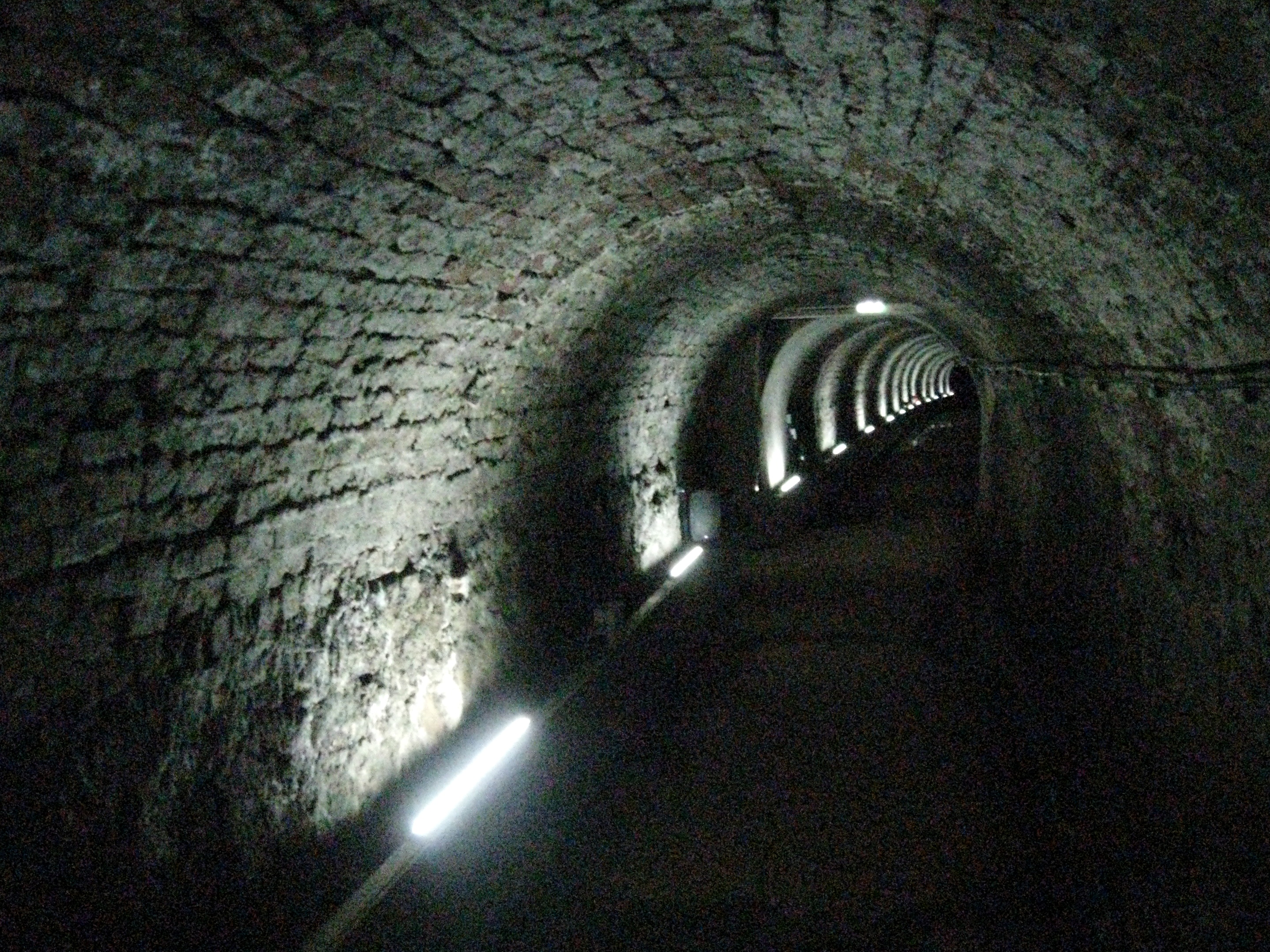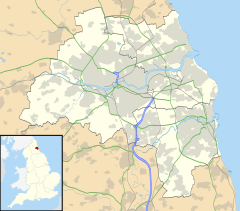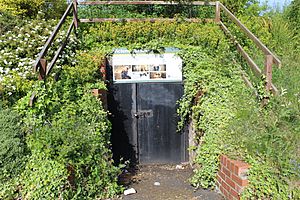Victoria Tunnel (Newcastle) facts for kids
 |
|
| A lit section of the Victoria Tunnel near the Ouse Street entrance | |
| Overview | |
|---|---|
| Location | Newcastle upon Tyne, England |
| Start | Town Moor |
| End | River Tyne |
| Operation | |
| Work begun | 1839 |
| Technical | |
| Length | 2.25 miles (3.6 km) |
| Lowest elevation | 26 meters |
The Victoria Tunnel is a long underground passage in Newcastle upon Tyne, England. It runs from the Town Moor all the way down to the River Tyne. This tunnel was built between 1839 and 1842. Its main purpose was to carry coal from the Leazes Main Colliery (a coal mine) to the river. From there, the coal could be loaded onto boats and shipped out.
The tunnel was dug through tough clay. Its walls are made of stone, and the roof is a strong brick arch. Loaded coal wagons would roll down the tunnel by themselves because of its slope. Empty wagons were pulled back up to the mine using ropes and a special engine. The coal mine closed in 1860, and the tunnel was left empty. However, at the start of World War II in 1939, it was turned into a safe place for people to hide from bombs.
The Victoria Tunnel is about 2.4 miles (3.9 km) long. At its deepest point, it is 85 feet (26 m) underground. The tunnel drops 222 feet (68 m) from its start to its end. Most of the tunnel is still in good condition today.
Contents
History of the Victoria Tunnel
Victorian Coal Transport
When the Leazes Main Colliery opened in 1835, many coal mines were operating around Newcastle. This was during the Industrial Revolution, a time when factories and machines were growing fast. There was a huge demand for coal, and mines competed to sell it.
At first, coal was moved from the mine through Newcastle's streets in carts. This was slow because the streets were narrow and cobbled. It was also expensive due to road taxes. So, the mine owners decided to build an underground passage. They hired William E. Gilhespie, a local engineer, to design it. An above-ground railway was considered, but the Freemen of Newcastle (people with special rights to the land) would not allow tracks across the Town Moor.
Building the Tunnel
Permission to build the tunnel was given in 1838, and work began the next year. The tunnel was likely dug in sections. Workers would dig a shaft down to the correct depth. Then, they would tunnel outwards to connect with the next section. John Cherry, a former lead miner, managed the digging. About 200 workers helped build the tunnel. On January 8, 1842, a big party was held for the workers to celebrate their hard work.
The tunnel's walls were lined with stone. A double brick arch supported the roof. It is about 7 ft 5 in (2.26 m) high and 6 ft 3 in (1.91 m) wide. This size was just right for the special chaldron wagons used to carry coal.
Moving the Coal
The tunnel had a gentle slope. This meant that loaded coal wagons could roll down to the river on a standard rail track by themselves. A rope was tied to the last wagon. A stationary steam engine at the top of the tunnel then pulled the empty wagons back up to the mine.
Grand Opening Day
The Victoria Tunnel was named after the young and popular Queen Victoria. The Mayor of Newcastle officially opened it on April 7, 1842. A large crowd, including important people, gathered by the river. At 1 PM, cannons fired as eight wagons came out of the tunnel. Four wagons carried coal. The others carried "ladies and gentlemen and a band of musicians."
Mine Closes
The Victoria Tunnel was a financial success. It made moving coal from the mine to the river 88% cheaper. However, the coal mine itself was not successful and closed in 1860. The tunnel, which took two and a half years to build, was used for only eighteen years.
Air Raid Shelter During WWII
In 1939, Britain got ready for war. People were told to prepare for "Air Raid Precautions" to protect themselves from bombs. In Newcastle, city planners decided to turn the Victoria Tunnel into a large air-raid shelter. It was designed to hold 9,000 people.
Changing the Tunnel
It cost £37,000 to change the tunnel into a shelter. Workers cleaned out coal dust and whitewashed some parts. Strong concrete walls were added to block bomb debris. Electric lights were put in, and a new concrete floor was laid. Wooden benches and about 500 bunk beds were installed. Simple chemical toilets were also built near the entrances.
Seven new entrances were built. These included Claremont Road, Hancock Museum, and Ouse Street. At Ouse Street, people could walk straight in. Other entrances looked like subway entrances, with steep corridors leading down.
Hiding in the Tunnel
The tunnel was a dark, damp, and uncomfortable place to shelter. Many people were scared to use it. Those who did remember sitting with their families and neighbors. They would share news and often sing songs. They waited nervously for the "all-clear" signal, which meant the danger was over.
After the War
When the war ended, most of the shelter's fittings were removed. All entrances except the one at Ouse Street were closed. This entrance was on private land. Today, guided tours are available for visitors.
Timeline of the Tunnel
- 1838: The mine owners get permission to build the tunnel. Work starts the next year.
- 1842: Construction finishes. The tunnel opens with a cannon salute and a party for the workers.
- 1860: The coal mine closes. The tunnel is no longer used.
- 1878: Part of the tunnel near the river is taken down when the Glass House Bridge is built.
- 1928: A man tries to grow mushrooms in the river end of the tunnel, but the business fails quickly.
- 1939: World War II begins. The tunnel is made into an air raid shelter with new entrances, beds, lights, and safety walls.
- 1945: The war ends. All entrances except one are blocked up. The tunnel is again left in darkness.
- 1954: The tunnel is considered as a possible nuclear shelter, and plans are made to reopen the World War II entrances.
- 1976: A section of the tunnel is turned into a sewer for waste water.
- 2006: Newcastle City Council gets money to fix the tunnel and open it to the public.
- 2010: The Ouseburn Trust takes over managing the tunnel tours.
Tunnel's Path
The Victoria Tunnel originally started near the Spital Tongues colliery. It still runs under Claremont Road and passes near the Hancock Museum. It then goes close to the Civic Centre and St Mary's Place. From there, it travels under Northumbria University City Campus, the Central Motorway, and Shieldfield. It continues to St Dominic's Church and then under St Ann's Estate to an entrance on Ouse Street. The part of the tunnel that went all the way to the River Tyne was removed in 1878.
Tunnel Facts and Figures
| Date opened | 7 April 1842 |
|---|---|
| Original length | 2+1⁄4 miles (4 km) |
| Original height | 7 feet 5 inches (2.26 metres) |
| Original width | 6 feet 3 inches (1.91 metres) |
| Drop | 222 feet (68 m) |
| Deepest point | 85 feet (26 m) |
| Length accessible today | 766 yards (700 m) |
Tunnel Restoration and Tours
A 766-yard (700 m) section of the tunnel in the Ouseburn Valley can still be visited. You can enter through a World War II entrance on Ouse Street. Public visits first started in 1998. After being closed for a while in 2006, Newcastle City Council repaired the tunnel and made it safe for visitors. This work was paid for by the Heritage Lottery Fund.
From 2009, the Victoria Tunnel Education Project created learning materials and organized tours and school workshops. Since 2010, The Ouseburn Trust has been running guided tours. There is also a special sound and light show inside the tunnel. It was created by artist Adinda van 't Klooster and explores themes of war and fear.



